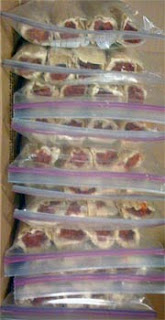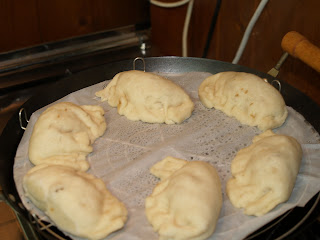
Freakin' spheroidal pancakes. Big deal. How does this novelty dish from your local Danish Culture Heritage Society make it into the hallowed pages of Frangykitchen? Well, it's like this.
A few months ago, my sister gave me some chokecherry syrup, which was given to her by Jim, her ex-boyfriend from when they were in their 20s. The jar was dated 2006 and it was one of the last jars put away by Jim's mom before she died. I remember tagging along as the little brother and visiting with Jim's family in Montana and picking baskets of wild chokecherries, which are astringent and scarcely edible when picked but can become indescribably transcendent as preserves—jam, compote, and syrup. "Can become" is the key here because not all chokecherry preserves are so great. Patsy tells me that Jim sends her chokecherry jams every once in a while (he still lives in Billings), but his are nowhere near as good as his mom's. [Don't tell Jim, though, and I'm counting on the dilution factor of one tiny post in the entirety of the blogosphere to keep this our little secret.] And so this is how I came to possess a very special half-pint jar of seemingly irreproducible delicacy. Maybe someday I'll make it my mission to rediscover the secrets of producing good chokecherry syrup, but for now I just need a worthy means of consuming it. That's part one.
Last week, my mom has me and a couple of friends over for a session of hard labor—moving around furniture, cleaning, etc. and we come across an old box with a nearly brand-spanking new cast-iron ebelskiver pan. Apparently Mom picked it up on one of their trips to Solvang, which is apparently something that my family used to do before I was born. Sure enough, Patsy remembers this, but I don't. No big—I've been to Solvang and know that I didn't miss out on much. I'm not a culture nut and never have been. Mom says that she used the pan exactly twice before putting it into storage. I asked if I could borrow it, and she said I could have it. It looked brand new. There's no way that this pan could have produced decent anything. With no seasoning of the bare metal, any food would stick like crazy.
Cast iron is my favorite cookware for many kinds of foods. Properly seasoned, it browns foods forming a beautiful crust that will generally detach nicely from the surface. So it is relatively non-stick, though in order to achieve this property you need to use adequate fat, the pan needs to be hot, and the cook must be patient, allowing enough time for the crust-forming to occur before moving the food. After cooking and while the pan is still hot, a quick wipe-down is all the cleaning that should occur, and if there is anything sticking to the pan, a bit of hot water can be used to loosen the little crusties before wiping them out. Under no circumstances should this pan be scrubbed with detergent, as this will remove the seasoning.
So what exactly is this seasoning? And faced with a brand-new, bare metal pan, how does one put on this seasoning? In my understanding, the coating is derived mostly from fats from the previous several cookings, chemically altered with heat and exposure to the iron surface so that it bonds with the metal and also thickens and semi-hardens to coat the metal. It's kind of a dynamic coating—each time you cook, a little bit of the fats gets incorporated into the coating while a little bit of the coating is lost by burning off.
To season a new pan, there are several methods, and you can find all of them on the Internet. The one that I have used involves washing the pan very well, coating it with oil and baking it, then letting it cool and repeating the process a few times. The result is a very attractive, shiny, orange-brown coating that in my experience has a tendency to peel at real cast-iron cooking temperatures, and is therefore little better (if not worse) than no coating at all.
My philosophy is that you have to develop the seasoning with use. In the case of the ebelskiver pan, I used a little extra oil in both the pan and the batter, and I just accepted that the first batch would stick until it became over-brown (i.e. burnt, but the dogs didn't mind). The second batch would be a little better. And by the time I put on the third batch of ebelskiver the result would be somewhat edible, which is a good thing because the dogs were getting rather sick of them.
After a week of daily use, the pan is finally seasoned and is making pretty nice ebelskiver. For a really good batter recipe, go to Karen's post on pancakes and follow the instructions, but add a generous tablespoon of melted butter for every 2/3 cup of batter, which should be on the thick side. The pan must be pre-heated over a low fire—hot, though not smoking—and about half a teaspoon of oil in each of the cups should be swirled around before adding the batter.
 The trick to cooking ebelskiver is the all-important quarter-turn. Once the batter has had a crusted to a light golden color, I use a wooden skewer to help detach the 'skivers from the pan before giving them a partial turn. The cooked hemispheres should now be vertical with one lip straight up and the other at the bottom of the cup. In the meantime the loose batter should run out to fill the half of the cup that was vacated. At this point they kind of look like three-D pac-men. Once you have a nice crust on the bottom of the pac-men, give them another partial turn so that their mouths are straight down.
The trick to cooking ebelskiver is the all-important quarter-turn. Once the batter has had a crusted to a light golden color, I use a wooden skewer to help detach the 'skivers from the pan before giving them a partial turn. The cooked hemispheres should now be vertical with one lip straight up and the other at the bottom of the cup. In the meantime the loose batter should run out to fill the half of the cup that was vacated. At this point they kind of look like three-D pac-men. Once you have a nice crust on the bottom of the pac-men, give them another partial turn so that their mouths are straight down.  Once crusted and golden all over, they are finally ready to take on the syrup made by the now-deceased mother of my sister's ex-boyfriend.
Once crusted and golden all over, they are finally ready to take on the syrup made by the now-deceased mother of my sister's ex-boyfriend.

























